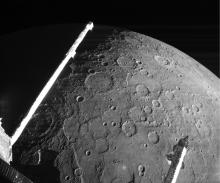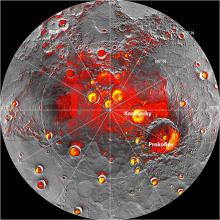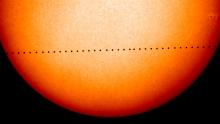Listen to today's episode of StarDate on the web the same day it airs in high-quality streaming audio without any extra ads or announcements. Choose a $8 one-month pass, or listen every day for a year for just $30.
You are here
Morning Mercury
When you have one of those days that seems to last forever, just be grateful you’re not on the planet Mercury. There, a single day lasts for two years.
Mercury is the closest planet to the Sun. The Sun’s gravitational pull has locked the planet in such a way that it spins on its axis three times for every two orbits it makes around the Sun. Because of the Sun’s changing position in the Mercury sky, that means that a “day” on Mercury — the time from one noon to the next — lasts for two full Mercury years — about 176 Earth days.
That doesn’t necessarily mean that sunsets or sunrises are 176 days apart, though. Mercury’s orbit is lopsided, so the planet’s orbital speed varies by quite a bit. Combined with the speed of its rotation, that creates some odd effects. From parts of the planet, during parts of its orbit, the Sun can rise, then reverse direction and set, then rise again. And there are double sunsets as well.
Mercury is putting in a decent showing as the Sun rises in our own sky. Next week, in fact, it’ll stand farthest from the Sun for its current morning appearance. It’s in the southeast as twilight paints the dawn, and looks like a fairly bright star. It’s so low that you need a clear horizon to spot it. Don’t confuse it with brilliant Venus, the “morning star,” well to the upper right, or with fainter Mars, which is closer to Venus. Mercury will slip from view in the dawn’s early light by late February.
Script by Damond Benningfield





